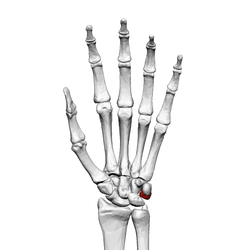Triquetral bone
| Triquetral bone | |
|---|---|

Left hand anterior view (palmar view). Triquetral bone shown in red.
|
|

The left triquetal bone
|
|
| Details | |
| Articulations | articulates with three bones: lunate laterally pisiform in front hamate distally triangular articular disk which separates it from the lower end of the ulna. |
| Identifiers | |
| Latin | os triquetrum, os pyramidale, os triangulare |
| MeSH | A02.835.232.087.319.150.831 |
| Dorlands /Elsevier |
o_07/12598819 |
| TA | A02.4.08.006 |
| FMA | 23715 |
|
Anatomical terms of bone
[]
|
|
The triquetral bone (/traɪˈkwɛtrəl/ or /traɪˈkwiːtrəl/; also called triquetrum, pyramidal, three-cornered or triangular bone, and formerly cuneiform bone) is located in the wrist on the medial side of the proximal row of the carpus between the lunate and pisiform bones. It is on the ulnar side of the hand, but does not articulate with the ulna. It connects with the pisiform, hamate, and lunate bones. It is the 3rd most commonly fractured carpal bone.
The triquetral is one of the eight carpal bones of the hand. It is a three-sided bone found within the proximal row of carpal bones. Situated beneath the pisiform, it is one of the carpal bones that form the carpal arch, within which lies the carpal tunnel.
The triangular bone may be distinguished by its pyramidal shape, and by an oval isolated facet for articulation with the pisiform bone. It is situated at the upper and ulnar side of the carpus. To facilitate its palpation in an exam, the hand must be radially deviated so that the triquetrium moves out from under the ulnar styloid process. The triquetrum may be difficult to find, since it also lies under the pisiform.
...
Wikipedia
